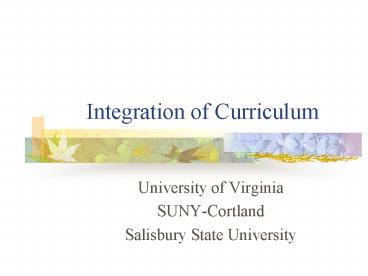Integration of Curriculum - PowerPoint PPT Presentation
1 / 24
Title:
Integration of Curriculum
Description:
Instruction is less abstract. Connections are made among subjects ... different backgrounds, grade levels, and/or learning techniques (multiple intelligences) ... – PowerPoint PPT presentation
Number of Views:5015
Avg rating:3.0/5.0
Title: Integration of Curriculum
1
Integration of Curriculum
- University of Virginia
- SUNY-Cortland
- Salisbury State University
2
Aspects of Integrated Curriculum
- An integrated curriculum is on that is focused on
the organization of central themes or concepts
which combines several subjects. - The goal of curriculum integration is to have
students gain a deeper level of understanding
across subject areas through interrelated
thematic study.
3
Benefits of Integration
- Relevance of instruction
- Instruction is less abstract
- Connections are made among subjects
- Students search for meanings instead of
memorizing facts - Students gain a sense of accomplishment
4
Integration in Maryland
- Integration is site-based
- Use is based on individual teachers decisions
- May not be used consistently within a school
5
Interviews in Maryland
- Interview 1 First Grade
- County mandated curriculum does not allow for
science instruction - Focus is on isolated reading and math with no
science instruction - Teacher tries to integrate subjects on her own
6
Interviews in Maryland (cont)
- Interview 2 Fifth Grade
- Based on a county mandated curriculum, fifth
grade teachers select four themes to use for
integration each year - Teachers feel their method is a good way to
integrate so students dont become overwhelmed by
the repetition of information
7
Interviews in Maryland (cont)
- Interview 3 College level
- Overlapping of subject content mirrors real life
situations - Everyday experiences are not isolated and
unrelated - Uniqueness of each subject should be preserved
8
Maryland State Policy
- State policy of integration is based on the
decision of individual teachers - However, Maryland textbooks offer the possibility
of integration by including interdisciplinary
activities
9
Two Models of Integration
- Rose Model
- Daisy Model
10
Multidisciplinary vs. Integration
- The multidisciplinary approach attempts to teach
thematic units which relate individual subjects
to a singular topic without making direct
connections across the curriculum. (Daisy model) - Integration curriculum unifies the subject matter
in the students minds through making connections
between subject areas and exploring how these
relate to their everyday lives. (Rose model) - Research by Beane (1997)
11
Illustration of Integration
12
Illustration of Multidisciplinary Approach
13
Interviews in Virginia
- Interview 1 Fourth grade science teacher
- Integration is difficult because of time
constraints. When we are in science class, I
need to be focused on science because I only have
the students for a limited amount of time. - Unfortunately, there are not a lot of materials
for integration. So, when I do integrate, I have
to create the materials on my own.
14
Interviews in Virginia (cont)
- Interview 2 Second grade teacher
- I use laser discs and trade books in my science
curriculum, trying to incorporate technology and
literature with science. - Integration helps to maintain open minds and the
ability to see science across diverse areas.
15
Virginia State Policy
- No state policy, especially for elementary
schools because of tight schedules and lack of
teacher training in science - High schools are given the option to schedule
integrated science class, but it is not required. - Within Albemarle Co., teachers often use science
as a hook to keep students interest in other
subject areas. (Science Curriculum Coordinator
for Albemarle Co.)
16
Elementary School Teachers Perspective on
Integration
- Appropriate for all students
- Allows for modifications for special needs
students - Materials and lessons are teacher developed
17
Integrate Curriculum for Animal Studies
- Read for information
- Make webs and write about animals
- Use measurement to determine size of animal
- Plot geographic location of the animal
- Locate migration paths
- Make a model of animal with clay
18
A SUNY-Cortland Professors Perspective
- Ellen Newman integrating curricula is
appropriate and helpful for all students with
different backgrounds, grade levels, and/or
learning techniques (multiple intelligences). - Should integrate all subjects, not just related
subjects like math and science
19
A Problem
- The distribution of integration materials and
guidelines vary depending on school districts.
20
Standards for Integration
- Only math, science and technology are integrated
in the NY State standards.
21
Ten Models of Curriculum
- Fragmented
- Connected
- Nested
- Sequenced
- Shared
- Webbed
- Threaded
- Integrated
- Immersed
- Networked
22
Conclusion
- Integrating curriculum has positive benefits for
students. - Connects concepts to real world experiences
- More time to explore concepts
- Able to see things from different angles
- Accommodates all students
- Helps students feel successful
- Fresh approach to learning
23
References
- Beane, J. (1992). Integrated Curriculum in the
Middle Schools. Eric Digest. Retrieved February
2, 2000 from the WWW http//www.ericeece.org/pub
s/digests/1992/beane92.html - Integrated Curriculum, Performance Assessment,
and Authentic Learning. Ideas and Directions.
(1996). Retrieved February 10, 2000 from the
WWW http//www.parkcce.org/id/3/intgr.html - Berlin, D.F., White A. L. (1994) The
Berlin-White Integrated Science and Mathematics
Model. School Science and Mathematics, 94(1).
2-4. - Martin, D.J. (2000) Elementary Science Methods a
Constructivist Approach. United States
Wadsworth/Thomson Learning. - McDonald, J., Czerniak, C. (1994). Developing
Interdisciplinary Units Strategies and Examples.
School Science and Mathematics. 94(1). 5-10.
24
(No Transcript)

